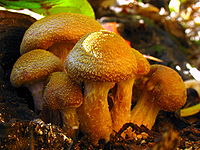Armillaria gallica (synonymous with A. bulbosa and A. lutea) is a species of honey mushroom in the family Physalacriaceae of the order Agaricales. The species is a common and ecologically important wood-decay fungus that can live as a saprobe, or as an opportunistic parasite in weakened tree hosts to cause root or butt rot. It has a widespread distribution, being found in temperate regions of Asia, North America, and Europe, and forms fruit bodies singly or in groups in soil or rotting wood. The fungus has been inadvertently introduced to South Africa. Armillaria gallica has had a confusing taxonomy, due in part to historical difficulties encountered in distinguishing between similar Armillaria species. The fungus received international attention in the early 1990s when an individual colony living in a Michigan forest was reported to cover an area of 15 hectares (37 acres), weigh at least 9,500 kilograms (21,000 lb), and be 1,500 years old. This individual is popularly known as the "humungous fungus", and is a tourist attraction and inspiration for an annual mushroom-themed festival in Crystal Falls.
Armillaria gallica is a largely subterranean fungus, and it produces fruit bodies that are up to about 10 cm (3.9 in) in diameter, yellow-brown, and covered with small scales. On the underside of the caps are gills that are white to creamy or pale orange. The stem may be up to 10 cm (3.9 in) long, with a white cobwebby ring that divides the color of the stem into pale orange to brown above, and lighter-colored below. The fungus can develop an extensive system of underground root-like structures, called rhizomorphs, that help it to efficiently decompose dead wood in temperate broadleaf and mixed forests. It has been the subject of considerable scientific research due to its importance as a plant pathogen, its ability to bioluminesce, its unusual life cycle, and its ability to form large and long-lived colonies.
